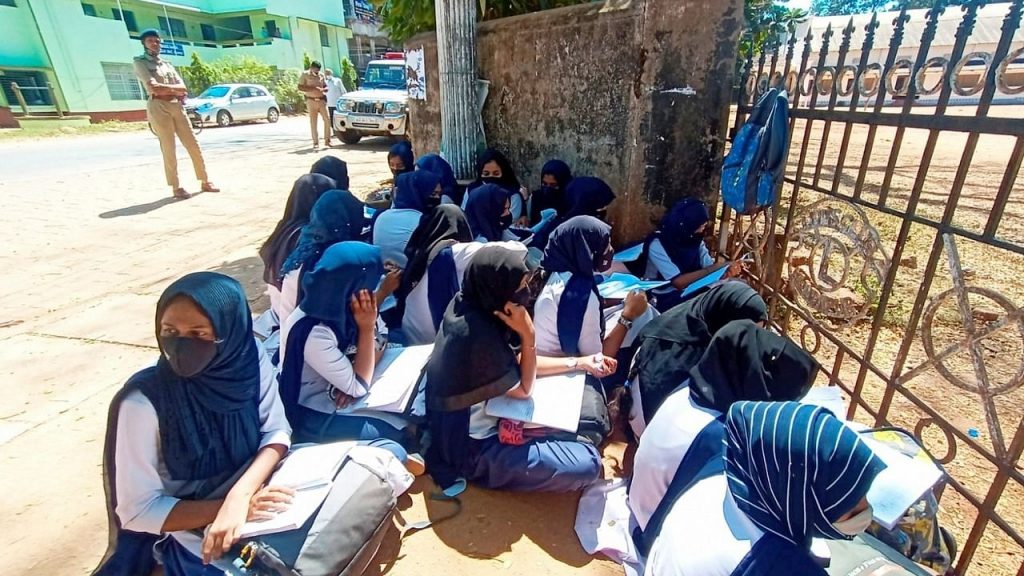The hijab controversy that has erupted in educational institutions in Karnataka is a disturbing development, to say the least. In a communally surcharged climate that has been prevailing in India for the past few years it is unfortunate the way the right to education and the right to religious freedom are being mixed up in the row over wearing hijab by Moslem girl students in several districts of Karnataka. The socio-religious tension triggered by the ugly incidents in some schools and colleges in Udupi, Kundapur and Byndoor is aggravated with BJP and Congress leaders and state ministers trying to fish in troubled waters. The communal overtone follows a set pattern each time major elections in state Assemblies are to take place. This time, when elections in crucial states such as Uttar Pradesh and Punjab are round the corner, it seems the intent is to whip up communal frenzy by targeting a sensitive, visible, religious symbol – the hijab – the scarf Moslem women wear round their heads as part of their religious practice. Interestingly, though Punjab will go to the polls, the religious symbol of the Sikhs – the turban- has not been targeted, though some schools in UP and Uttarakhand a few years back tried to ban wearing of large turbans by school students in the states.
The right to profess religion and the right to education clashed when Moslem students wearing hijabs were denied entry by authorities into a government pre-university college last week at Kundapur in Karnataka’s Udupi district. The students forced their way into the college premises flouting the authorities’ strict orders that wearing hijab would not be allowed as per the status quo on the dress code issued by the state government. State Education Minister BC Nagesh added fuel to fire when he said the girl students had not been wearing the hijab earlier. According to him, the entire issue cropped up early January when six students attended classes wearing hijab in violation of the dress code in classrooms at the government girls’ pre-university (PU) college at Udupi. The controversy snowballed into a political slanging match between the BJP and the Congress when Karnataka state ministers intervened in the matter. As a mark of protest against allowing Moslem students to wear hijab inside the educational institution, boys, seemingly instigated by right wing outfits, also started to wear saffron scarves and raise religious slogans. Since such scarves have never existed as religious symbol, some institutes ordered the boys to remove them and follow the dress code. But the question is whether the practice of wearing the religious symbol of one particular faith is a result of mixing education and politics on the grounds of religion. The BJP seized the opportunity to make political capital of the issue when the Congress leader and MP Shashi Tharoor supported the protesting Moslem girls and asked some blunt questions about religious attire. For example, one of his loaded questions was, “if the hijab is disallowed, what about the Sikh turban? The Hindu’s forehead mark? The Christian’s crucifix?”
The Indian Constitution provides ‘Freedom of Religion’ as a fundamental right guaranteed by Articles 25 to 28. Every citizen of India has a right to practice and promote their religion peacefully. However, as a bitter truth, numerous incidents of religious intolerance have resulted in riots and violence, such as anti-Sikh massacre in 1984, the anti-Hindoo riots in 1990, Gujarat riots in 2002, anti-Christian riots in 2008 and very recent Delhi riots in 2020.
The BJP governments have been showing the proclivity of branding protesters in academic institutions, who challenge the government’s fiat, as either terrorists or having links with terrorist outfits both inside and outside the country. The same tendency is being displayed in the hijab case as well. Though the Karnataka High Court is all set to hear the hijab-related writ petition February 8, the state government has now started to probe the six girls of Government PU College in Udupi, who are demanding permission to wear the hijab inside the classroom.
BJP MLA Raghupati Bhat has stated state Home Minister Araga Jnyanendra asked the police to probe any links that the girls and their parents may have with other organisations. Any meetings attended by the girls and their call records will be under scrutiny. As if to confirm the by now well know pattern, the MLA asserts it is important to ascertain if the girls are acting on behalf of any international or terror organisations. On the other hand, two people have been arrested for carrying arms into a protest on the hijab row. The police are on the lookout for another three. The appearance of such elements during students’ agitation has also been part of a known scenario in Delhi and elsewhere as well.
At this stage an interesting development is the decision of one educational institution of Karnataka to let in protesting hijab-wearing girls students, though they were accommodated in a separate room and not in their usual classroom. This is explained as a move to prevent escalation of trouble before the court ruling.
The Karnataka High Court’s verdict is being eagerly awaited. Sober minds are the need of the hour to prevent bigots and their political handlers from inflicting fresh wounds on the nation in the name of religion, reaping political dividends and destroying the country’s age-old tradition of pluralism.
